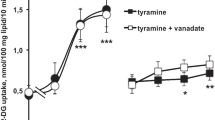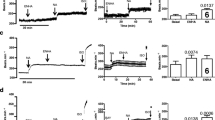Summary
The influence of pretreatment of hamsters and of intact hamster adipocytes with the heterocyclic carboxylic acid, 3-carboxy-5-methylpyrazole (CMP) was studied on the inhibitory effects of various antilipolytic agents on adenylate cyclase in membrane preparations. In vivo pretreatment of hamsters for 3 days with the potent antilipolytic agent, CMP (40 mg/kg b.w., twice daily), markedly reduced the inhibitory potencies of CMP itself and of nicotinic acid on the adenylate cyclase. In contrast, enzyme inhibition by PGE1 remained unchanged. Increase in adenylate cyclase activity due to the stimulatory hormone, ACTH, and basal activity were enlarged in adipocyte membranes from CMP-pretreated hamsters compared to controls. In vitro pretreatment of intact hamster adipocytes with CMP at a maximally effective concentration (300 μM) caused a time-dependent decrease in adenylate cyclase inhibition by CMP itself; upon pretreatment for 120 min, inhibition was diminished by about 50%. Identical decreases in the inhibitory potencies were observed for nicotinic acid and for 3-carboxy-5-methylisoxazole, another carboxylic acid. In contrast, inhibitions of the adipocyte adenylate cyclase by PGE1, adrenaline and N6-phenylisopropyladenosine were not changed by the in vitro pretreatment with CMP. The data indicate that adipocyte adenylate cyclase inhibition can desensitize following both in vivo and in vitro administration of an inhibitory agent. The desensitization process and the specificity observed give further support to the idea that inhibition of adipocyte adenylate cyclase by nicotinic acid is mediated by a membrane receptor and, additionally, suggest that nicotinic acid and the heterocyclic carboxylic acids studied act via a common receptor.
Similar content being viewed by others
References
Aktories K, Schultz G, Jakobs KH (1979) Inhibition of hamster fat cell adenylate cyclase by prostaglandin E1 and epinephrine: Requirement for GTP and sodium ions. FEBS Lett 107:100–104
Aktories K, Schultz G, Jakobs KH (1980a) Regulation of adenylate cyclase activity in hamster adipocytes: Inhibition by prostaglandins, α-adrenergic agonists and nicotinic acid. Naunyn-Schmiedeberg's Arch Pharmacol 312:167–173
Aktories K, Jakobs KH, Schultz G (1980b) Nicotinic acid inhibits adipocyte adenylate cyclase in a hormone-like manner. FEBS Lett 115:11–14
Aktories K, Schultz G, Jakobs KH (1981) Na+ amplifies adenosine receptor-mediated inhibition of adipocyte adenylate cyclase. Eur J Pharmacol 71:157–160
Butcher RW, Baird CE, Sutherland EW (1968) Effects of lipolytic and antilipolytic substances on adenosine-3′,5′-monophosphate levels in isolated fat cells. J Biol Chem 243:1705–1712
Fain JN (1973) Biochemical aspects of drug and hormone action on adipose tissue. Pharmacol Rev 25:67–118
Jakobs KH, Saur W, Schultz G (1976) Reduction of adenylate cyclase activity in lysates of human platelets by the alpha-adrenergic component of epinephrine. J Cyclic Nucleotide Res 2:381–392
Lefkowitz RJ, Wessels MR, Stadel JM (1980) Hormones receptors, and cyclic AMP: Their role in target cell refractoriness. Curr Top Cell Regul 17:205–229
Lowry OH, Rosebrough NJ, Farr AL, Randall RJ (1951) Protein measurement with the Folin phenol reagent. J Biol Chem 193:265–275
Moreno FJ, Shepard RE, Fain JN (1979) Effect of NAD, nicotinamide and nicotinic acid on cyclic AMP accumulation by fat cells. Naunyn-Schmiedeberg's Arch Pharmacol 306:179–183
Nathanson NM, Klein WL, Nirenberg M (1978) Regulation of adenylate cyclase activity mediated by muscarinic acetylcholine receptors. Proc Natl Acad Sci USA 75:1788–1791
Pereira JN, Holland GF (1967) The development of resistence to a potent lipolysis inhibitor, 3-methylisoxazol-5-carboxylic acid. J Pharmacol Exp Ther 157:381–387
Sabol SL, Nirenberg M (1979) Regulation of adenylate cyclase of neuroblastoma x glioma hybrid cells by α-adrenergic receptors. II. Long lived increase of adenylate cyclase activity mediated by α receptors. J Biol Chem 254:1921–1926
Schimmel RJ, Serio R, Hsueh AY, Firman-White L (1980) Inhibition of lipolysis in hamster adipocytes with selective α adrenergic stimuli: functional characterization of the α receptor. Biochim Biophys Acta 629:83–94
Schimmel RJ, McMahon KK Serio R (1981) Interactions between alpha-adrenergic agents, prostaglandin E1, nicotinic acid, and adenosine in regulation of lipolysis in hamster epididymal adipocytes. Mol Pharmacol 19:248–255
Schwabe U, Kerstein E, Hasselblatt A (1968) Hemmung der Lipolyse im Fettgewebe durch Methylisoxazolcarbonsäuren. Naunyn-Schmiedeberg's Arch Pharmakol Exp Pathol 260:1–15
Sharma SK, Klee WA, Nirenberg M (1975) Dual regulation of adenylate cyclase accounts for narcotic dependence and tolerance. Proc Natl Acad Sci USA 72:3092–3096
Trost T, Schwabe U, (1981) Adenosine receptors in fat cells: Identification by (-)-N6-[3H]phenylisopropyladenosine binding. Mol Pharmacol 19:228–235
Walseth TF, Johnson RA (1979) The enzymatic preparation of [α-32P]-nucleoside triphosphates cyclic [32P]AMP, and cyclic [32P]GMP. Biochim Biophys Acta 562:11–31
Wilkening D, Nirenberg M (1980) Lipid requirement for long-lived morphine-dependent activations of adenylate cyclase of neuroblastoma x glioma hybrid cells. J Neurochem 34:321–326
Author information
Authors and Affiliations
Rights and permissions
About this article
Cite this article
Aktories, K., Jakobs, K.H. In vivo and in vitro desensitization of nicotinic acid-induced adipocyte adenylate cyclase inhibition. Naunyn-Schmiedeberg's Arch. Pharmacol. 318, 241–245 (1982). https://doi.org/10.1007/BF00500486
Received:
Accepted:
Issue Date:
DOI: https://doi.org/10.1007/BF00500486




